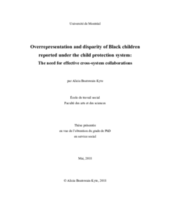This three-paper dissertation examines the overrepresentation of Black children reported to child protection services in Canada. The first and second papers examine rates of service disparities using clinical-administrative data provided by a child protection agency for a sample of Black, White, and other visible minority children residing in Montreal, Quebec. Findings from the first paper reveal that compared to White children, Black children’s protection reports were five times more likely to be screened in, substantiated, and brought to court. Black children were also five times more likely than White children to enter out-of-home placement. Findings from the second paper demonstrate disparity in exits from the child protection system through comparison of Black, White and other visible minority children on time spent in out of home placement and likelihood of family reunification. Of these three groups, Black children spent the longest time in out-of-home placement and had a lower proportion of children experiencing family reunification. This decreased likelihood of reunification was statistically associated with three variables: placement instability, age of the child and type of maltreatment. The accessibility of support services within a child’s community to help moderate exposure to risk conditions has been offered as a possible solution in addressing the overrepresentation of Black children. The third paper in this dissertation uses qualitative inquiry employing a thematic approach to highlight some of the challenges faced by a collaboration between a child protection agency and community organization. The creation of the partnership sought to reduce overrepresentation of Black children receiving services from the child protection system. It aimed to improve socioeconomic conditions faced by Black families by providing access to support services to address their needs in a culturally adapted manner. In depth-interviews from members of the stakeholder committee composed of management staff from both the child protection agency and community organization cited challenges pertaining to the child protection agency’s organizational context, level of socio-political support and organizational culture as obstacles to an effective partnership. Together, these three papers document the nature and potential causes of overrepresentation and disparity faced by Black Canadian children. It suggests that the disproportionate need faced by Black families is an important factor explaining their differential treatment within child protection systems. This study also highlights some of the potential barriers in implementing solutions.

